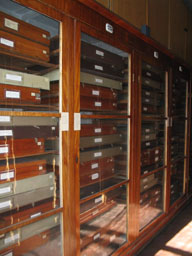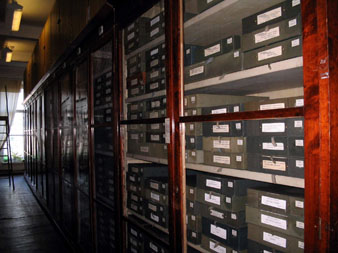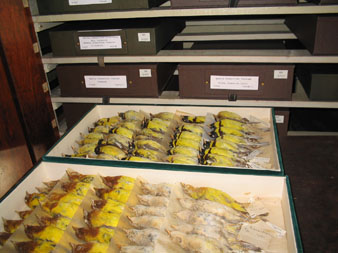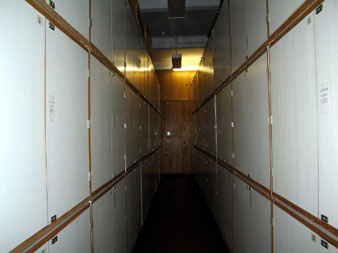Department of Ornithology
About Department
(since mid 20th century until early 21st century)
In the latter half of the last century the heads of the Department of Ornithology were A.I. Ivanov (1949–1969) and K.A. Yudin (1969–1978); since 1978 its head is V.M. Loskot. Apart from A.I. Ivanov and K.A. Yudin, other former students of Academician P.P. Sushkin, outstanding ornithologists B.K. Stegmann, L.A. Portenko, E.V. Kozlova worked at the Department during this period. Their contribution to ornithology was large and diverse.

The studies of B.K. Stegmann (1950, 1955, 1958, 1961, 1962, 1964, 1967, 1968, 1970, 1974, 1978) and K.A. Yudin (1958, 1961, 1964, 1965, 1970, 1974, 1978a, 1978b) brought a considerable progress to avian biomechanics, comparative and functional morphology which was aimed to improve the system of the large avian taxa. Comparative morpho-functional analysis of such vital structures as osteomuscular apparatus of cranium and extremities, together with a synthesis of ecological and ethological data made it possible to use the transformations of these structures for reconstructing the phylogeny of separate groups. Such studies belong to the highest, morphobiological level of systematics sensu Yudin (1974, 1983) who was an important and original theoretician of systematics. The benefits of this approach are perfectly illustrated by Stegmann's works on rails, corvids, doves, sandgrouses, divers (loons), grebes and waders (1952, 1955, 1957а, 1957b, 1958, 1968, 1974, 1978). His conclusion of the phylogenetic closeness of Galliformes and Anseriformes was later confirmed by DNA hybridization studies. E.V. Kozlova in her two-volume monograph (1961, 1962) devoted to the suborder Charadrii also used the data of comparative anatomy, biology and biogeography when revising the group's system. In Yudin's (1965) work "Phylogeny and classification of Charadriiformes" the morphobiological method reached its complete development and allowed the author to define the volume of the order, the main directions of its evolution and phylogenetic relationships with other orders. Later this method was successfully applied by B.V. Nekrasov (1978) who studied the morphobiological features of the jaw apparatus of finches related to seed-eating, and A.M. Sokolov (1991) when studying the systematics and phylogeny of procellariiforms. The summarizing work by K.A. Yudin "Biological significance and evolution of cranium kinetism in birds" (1970) is of primary importance for the understanding of evolution of the whole class Aves and their reptile ancestors.

The problems of evolution, phylogeny and systematics are treated in the volumes of the fundamental series "Fauna of the USSR". Three volumes are devoted to alcids and waders (E.V. Kozlova, 1957, 1961, 1962), one to tetraonids by R.L. Potapov (1985) who, as a member of stuff of the Zoological Institute's Museum, actively collaborated with the Department of Ornithology, and one, under the altered title "Fauna of Russia and adjacent countries", was devoted to skuas and gulls of the Larinae subfamily (K.A. Yudin and L.V. Firsova, 2002).
The results of intensive study of geographic variation of USSR's passerines were reflected in the two volumes of the identification guide "The birds of the USSR" written by L.A. Portenko (1954, 1960). Even though the author often treated species too broadly, and genera – too narrowly, the importance of his revisions cannot be overestimated. A number of V.M. Loskot's publications (Loskot, 1972, 1978, 1981, 1982, 1986 a, b, 1991a, b, 2000, 2001, 2005, 2006, 2014, 2015; Loskot, Abramson, 2006; Loskot & Sokolov, 1993; Loskot, Red'kin, Nechaev, 2013; Mlikovsky J. & V.M. Loskot. 2013; Rapozo, Stopiglia, Loskot, Kirwan, 2006; Rapozo, M.A., Kirwan G.M., V. Loskot & S.P. de Assis, 2012; Round & Loskot, 1994) is devoted to the problem of species in birds, species boundaries, intraspecific variation, speciation and hybridisation of related forms.

One of the main research directions of the Department's staff is also avifaunistics. The best examples of regional avifaunas are the monographs by A.I. Ivanov "The birds of Pamiro-Alay" (1969), by E.V. Kozlova "Avifauna of the Tibetan Plateau, its genetic relationships and history" (1952) and "The birds of zonal steppes and deserts of Central Asia" (1975), by L.A. Portenko "The birds of the Chukchi Peninsula and Wrangel Island" (1972–1973). As a result of summarising long-term collections and observations publications on the birds of Karelia and Amur Region were produced (I.A. Neufeldt 1958, 1959, 1960а, 1960б, 1963, 1965), on birds of Taimyr (A.V. Krechmar 1966), the Pamirs (R.L. Potapov, 1966) and Koryak highlands (A.A. Kistchinski 1980). The avifauna of Burein-Khingan lowland (S.V. Winter, 1983) and southeastern Transbaikalia (E.P. Sokolov, 1988) were studied. These reviews form an important stage in the study of avifauna of Russia and adjacent countries and still remain an important source of primary information.

Among the reference works the outstanding identification keys compiled by B.K. Stegmann stand apart. "The short identification guide to the birds of the USSR", co-authored by him and A.I. Ivanov was published in two editions (1964, 1978) and belongs to the best publications of this kind. K.A. Yudin compiled a superb identification guide to procellariiforms of Antarctic and sub-Antarctic waters, and distribution maps of seabirds of the Atlantic and Indian Oceans (1968, 1977). "The catalogue of the birds of the USSR" (1976) by A.I. Ivanov and the three volumes of bibliographic directory "Birds of the USSR" (1972, 1979, 1992) which contained over 18,000 entries on ornithological books and papers published in 1881–1970 and was edited and partly compiled by him were widely acknowledged.
In 1960–1992, 18 issues of "Atlas der Verbreitung paläarktischer Vögel" containing the data on 210 species were published. This edition was founded by E. Stresemann and L.A. Portenko and was published in German in Berlin by the ornithologists from the Zoological Museum of Alexander-von-Humboldt University of Berlin and the Zoological Institute of Russian (Soviet) Academy of Sciences (L.A. Portenko, I.A. Neufeldt, V.M. Loskot, E.P. Sokolov, V.M. Khabryi]. This unique edition contains contour or dot maps of birds' distribution areas, cadastre information on the confirmed breeding sites, summarized data on systematics, habitat use, numbers, breeding, migration timing and routes. The Atlas is an important reference for ornithologists, biogeographers, parasitologists, virologists, conservation biologists.

The lack of reliable data on biology of many avian species is a major obstacle for the successful development of systematics and phylogeny. The series of studies of I.A. Neufeldt, V.M. Loskot, L.V. Firsova, S.V. Winter, E.P. Sokolov on rare and little known birds of the Caucasus, Middle Asia, Altai and the Far East facilitate to fill this gap.
Long-term studies of V.M. Khrabryi are aimed to solve the difficult problems of biology of birds in the world's northernmost megalopolis. Khrabryi published the books "The birds of St. Petersburg: fauna, distribution, conservation" (1991) and "The birds of St. Petersburg. Illustrative reference book (2015)", also a series of papers (1988; 2004 à, b; 2005, 2006 à, b; 2007; 2008; 2012).
The tradition of studying fossil birds laid by P.P. Sushkin and A.Y. Tugarinov is continued by A.V. Panteleyev who published a number of papers on the systematics and phylogeny of late Cretaceous (subclass Enantiornithes) and Paleogenic birds, and on Quaternary passerines of Asia (Panteleyev, 1998, 2002, 2005, 2006 à,á, 2008, 2011, 2012 à, á, 2015;; Nesov & Panteleyev, 1993; Panteleyev & Nesov, 1993; Potapova & Panteleyev, 1999; Panteleev et al., 2004; Panteleev et al., 2006; Titov et al., 2006; Mannermaa et al., 2008; Sablin et al., 2011; Zelenkov, Panteleev, 2015). He described ca. 30 new taxa, developed identification key for passerines on the bases of osteological characters and compiled electronic directories to osteological and paleontological collections and the collection of specimens stored in alcohol.
The interest of A.Y. Tugarinov to the study of bird migration by means of ringing and the organization at the Zoological Institute of the first meeting on bird migration (1946) predetermined the advent of ornithologists studying avian migration at the Zoological Institute. By the decision of the Presidium of the Academy of Sciences the Biological Station Rybachy was founded in 1956 on the Courish Spit in Rybachy (Kaliningrad Region) to replace the former German ornithological station "Vogelwarte Rossitten". The first station's director was L.O. Belopolsky who had shortly before that defended his D.Sc. thesis at the Zoological Institute. This study was published as a monograph "Ecology of colonial sea birds in Barents Sea" in 1957 (English edition 1961; the book is still widely referenced).

Biological Station Rybachy keeps most close contacts with the Department of Ornithology, because during winter time, the station's researchers work in the Zoological Institute. At the Biological Station, mass trapping of many bird species, measurements and ringing are conducted. When V.R. Dolnik (1938-2013) started his studies at the Biological Station, quantitative experimental research was launched.
V.R. Dolnik studied the mechanisms of seasonal cycles in birds on the basis of endogenous circannual and circadian programmes synchronized with the astronomical calendar by photoperiod during mono- and multifactorial regulation periods. He developed a theory of migratory disposition in birds and its regulation (monograph "Migratory disposition in birds", 1975), methods of mass trapping and measuring the birds which formed the foundation for long-term large-scale computer-based monitoring. In fundamental bioenergetics V.R. Dolnik developed the concept of bioenergetic similarity underlying the energetics of vertebrates, developed an energetic model of an individual and a species, and the method of calculating energy budgets of free-living animals on the basis of their time budgets and allometric equations. The results of these studies are summarized in many papers (Dolnik, 1998,1999,2000,2002, Dolnik & Gorshkov, 1980, Dolnik et al.,1977, and in the book "Energy and time resources of free-living birds" (1995).
V.A. Payevsky in the beginning of his career (in 1961–1965 and 1968–1996 he worked at the Biological Station Rybachy, since 1997 at the Department of Ornithology) studied territorial distribution of birds of different seasons and published "Atlas of bird migration on the basis of ringing data (1971, English edition 1973). New important fields are the studies of population structure in birds, fecundity, mortality rate and dynamics of numbers (Payevsky 1974, 1976, 1977, Dolnik, Payevsky 1979) summarized in the monographs by V.A. Payevsky "Avian Demography" (1985), "Demographic structure and population dynamics of songbirds" (2008) and "Songbird Demography" (2009). In recent years several reviews about the systematics of true finches were published by V. Payevsky. His monograph "True finches of the world" (2015) summarizes the results of world-wide research into the systematics and life history of the finches (family Fringillidae). The phylogeny and classification, size and mass of the body, some features of morphology, moult, habitats, ecological niches, abundance and its fluctuations, impact of global climate changes, age and sex structure, philopatry, ecology of reproductive period and sesonal movements are reviewed in this monograph.

Avian population structure is also studied by V.G. Vysotsky. He uses stochastic demographic models to estimate survival parameters and to study the population dynamics (Vysotsky 2001, 2005, 2006, 2013, 2014, 2016, 2017; Vysotsky, Iljinsky 2004, 2007, 2008, 2015; Vysotsky, Payevsky 2002; Payevsky & Vysotsky 2003), and DNA-based methods for non-invasive sexing of birds, nestlings including (Sokolov, Vysotsky 2001).
Many well known specialists prepared their Ph.D. or D.Sc. theses at the Department of Ornithology, e.g. L.M. Shulpin, I.A. Dolgushin, L.O. Belopolsky, Y.V. Averin, V.A. Popov, I.A. Abdusalyamov, N.F. Reumers, A.V. Krechmar, R.L. Potapov, A.A. Kistchinski, B.O. Geilikman.
The Department's researchers see one of their main aims in the developmenty the collections, improving storing and working conditions. The collection is one of the three largest ornithological collections in Europe and comprises more than 170 000 skins of 4200 bird species, 2960 complete and 2240 incomplete skeletons of 1144 species, 7500 specimens of 850 species stored in alcohol, many nests and eggs; altogether more than 200 000 items.
Among the oldest specimens of the collectrion received in XVIII century are few exhibits from the Kunstkammer of Peter the Great (skeleton of Raven, stuffed Cape Sugarbird, Promerops cafer and some others). At the beginning of XIX century the collections of the First Russian Antarctic Expedition of F.F. Bellinsgausen and M.P. Lazarev on the sloops Vostok and Mirny in 1819-1821, academician G.H. Lagsdorff’s expedition to Brazil in 1821-1829 and F.H. Kittlitz in the voyage round the world on the corvette Senyavin in 1826-1829 were received. 754 specimens of 314 bird species, among them unique specimens of species which are now extinct, were collected by F.H. Kittlitz (see Mlikovsky, J. & Loskot, V. M. 2016).
The collection is unique and of global importance due to rich materials collected in Central Asia by G.N. Potanin, N.M. Przewalski and P.K. Kozlov expeditions. The fauna of Russia and adjacent countries is very completely represented. This is especially true for such regions as the Arctic, the Causasus, Middle Asia, Altai, Yenisey basin in Siberia and Primorye. Many Palaearctic species are represented by series including 200–400 specimens which makes it possible to study their intraspecific variation in much detail. The Nearctic fauna is also well represented, the first American collections were brought by I.G. Voznesensky from Alaska and California. The birds of South-East Asia are also represented satisfactory well. The collection contains the type specimens of birds described by F.F. Brandt, E. Menetries, E.A. Eversmann, A.F. Middendorff, G.I. Radde, N.M. Przewalski, F.D. Pleske, V.L. Bianchi. Most interesting are the skins of 12 species and 6 subspecies of birds that became extinct in the 19th–20th centuries, including Steller's Cormorant, Labrador Duck, flightless Great Auk, birds from Caroline and Bonin islands.

The palaeoornithological collection includes over 360 fossils of late Cretaceous, Paleogene and Neogene birds (incl. 27 type specimens) and ca. 150,000 bones of Quaternary birds. A large work in making inventories, completing and storing the collection was done by the technicians I.L. Kürschner, M.S. Yagunova and E.A. Shapoval; much has been done by A.G. Veselkin.
The Department is doing a large job by facilitating the work and consulting Russian and foreign specialists.